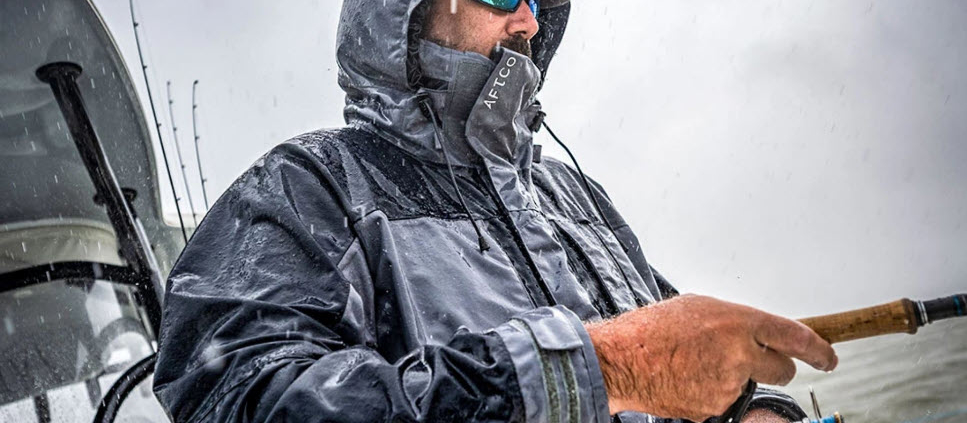Some of the best fishing days can go down in the rain, which can be very uncomfortable. You have a “waterproof” jacket to help with that. So why are you still wet after fishing in the rain? All clothing has different grades of water resistance. Here is a quick explanation of some common terms and waterproof ratings for AFTCO outerwear.
What Makes Clothing Waterproof?
No fabric used to make comfortable fishing clothing is fully waterproof. Waterproof is a term used in outdoor clothing to describe the next level passed water resistance. Resistance means light rain and splash proof, whereas “waterproof” means it can withstand heavy rain and keep you comfortable. BUT these are not submersible.
Unfortunately, there is no breathable/comfortable fabric that is completely waterproof in the fishing clothing industry YET. If a rain suit says that it is breathable at any rating, then it cannot be 100% waterproof. There is always a chance that the clothing you wear to fish in the rain can “spring a leak” and start letting water in, but being familiar with the types of fabric and terms for waterproof ratings can help when purchasing your next set of rain gear to ensure you get the best set possible.
You may ask yourself “why do I want my suit to be breathable if it makes it not 100% waterproof?”. Well think about those rubber slickers you see on Deadliest Catch. These are 100% waterproof, but they are 0% breathable. So, when it is warm out and you start to sweat, there is nowhere for moisture to go if the suit is not breathable as well. The 100% waterproof ability of these slickers, although extremely useful for their purposes, is also their downfall as fishing rain suits. They don’t end up keeping you dry because your sweat will soak you before the rain does. That is why fishing rain jackets are designed the way they are. How, you may ask?

Many rain jackets and bibs are made of nylon shells, treated with a waterproof coating called Durable Water Repellent or DWR. This helps water bead and then roll off the fabric. That is the first line of defense.
Inside that outer shell, there is at least one other layer. This layer is a waterproof breathable membrane. Lets break down this membrane. The outer side of this membrane is hydrophobic. That means it repels water if any gets in. The inner side is hydrophilic which means it attracts water. What you get is a piece of clothing that repels water droplets from the outside, but allows for air and water vapor from sweat to escape from the inside. Amazing, right?! Most waterproof clothing has at least these two layers and some premium jackets will have 3 layers. The third layer is a protective inner layer to the membrane. Added protection means longevity and durability of the jacket.
All of this does not mean that clothing companies are wrong about calling their clothing waterproof just because they cannot be submerged in water and stay dry. Please do not go into a typhoon hoping to stay dry in your rain jackets. Also, there are different levels of these waterproof jackets. This is usually reflected by the price of the suit. Lets dive into these levels and ratings of waterproof rain suits.
Waterproof Ratings / Breathability Ratings and How We Rate AFTCO Outerwear
Waterproof fishing clothing Waterproof fishing clothing measures waterproof and breathability in millimeters as a K rating. These ratings refer to how much water pressure the fabric can withstand before water penetrates. For example, a 20K rating means that the fabric, when placed over a 1-inch diameter tube filled with water, can withstand 20,000 mm of pressure before letting the water in.
Breathability is also measured in K ratings. However, this measurement refers to the amount of water that escapes the clothing over a 24-hour period. Therefore, a 10K breathability rating means that 10,000 grams of water vapor will escape in 24 hours.
Why is my jacket not waterproof when its says it is?
Now that you can see where we get these waterproof ratings from, you can also see that rain suits have levels of waterproofing as well. A simple standard is the higher the waterproof rating, the more waterproof it is. So, wearing a 30K jacket in light rain is a little overkill, although not as much of an issue as wearing a 5K rain jacket in a torrential downpour. Wearing a jacket that is not quite rated to handle the weather you are in would be a reason your jacket does not seem as waterproof as you would like it.
Another reason a jacket may not be keeping water out is because the DWR coating has worn off allowing too much water passed the outer shell. A tell tale sign this is what happened is if water is no longer beading on your jacket and it is soaking in immediately. This will then require you to retreat the outerwear with DWR coating which can be found here with our Nikwax Outerwear Care.
Once your jacket has been retreated, it should be beading water droplets again. If you are still getting wet, consider making sure the jacket has a waterproof rating that matches the weather you are dealing with on the water.
AFTCO rain suits start at 10K and go to 30K waterproof rating. At 30K you can ensure that rain or snow, you will stay dry out on the water. In winter, make sure to look at the AFTCO insulated jackets like the Hydronaut, and in the summer reach for the other options. If you are interested in one rain suit, look at the shell style suits, and make sure to layer in cold weather. Learn more about layering in our 8 gear tips for cold weather fishing blog.

